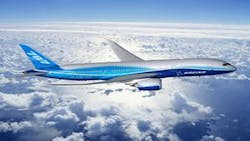Dreamliner Fire Probe Recommends Boeing Disable Beacons
LONDON -- British authorities recommended on Thursday that distress beacons onboard all Boeing Dreamliners be disabled, after identifying the devices as the likely cause of a fire on a 787 at London's Heathrow airport.
The Air Accidents Investigation Branch (AAIB) said that detailed analysis of the Honeywell emergency location transmitter system on the new generation plane "has shown some indications of disruption to the battery cells."
"It is not clear, however, whether the combustion in the area of the ELT was initiated by a release of energy within the batteries or by an external mechanism such as an electrical short," it said.
Pending further investigations, it recommended all Honeywell transmitters be removed from the Dreamliners and urged aviation regulators to review lithium-powered devices installed in other types of aircraft.
Boeing said it supported the recommendations, "which we think are reasonable precautionary measures to take as the investigation proceeds."
Nobody was hurt when the fire broke out Friday on an empty Ethiopian Airlines plane parked at Heathrow airport. But the incident was a blow to Boeing, which withdrew from service its entire fleet of Dreamliners earlier this year due to separate concerns that lithium-ion batteries on board could cause fires.
A total of 68 Dreamliners have so far been delivered, and the AAIB recommended to the Federal Aviation Administration that the transmitter systems in all of them be disabled.
It also recommended that the FAA and other regulatory authorities "conduct a safety review of installations of lithium-powered emergency locator transmitter systems in other aircraft types and, where appropriate, initiate airworthiness action."
Company is Confident that 787 is Safe
The AAIB's report does not mean the Dreamliner fleet need be grounded. All planes carrying passengers in the United States are required to have a distress beacon, and the devices are widely used around the globe. But under U.S. rules, operators can fly with inoperative transmitters for up to 90 days while they await replacement or repairs. Similar regulations apply in Europe and other parts of the world.
Boeing said it was working "proactively" to respond to the recommendations. "We are confident the 787 is safe and we stand behind its overall integrity," the company said.
Thomson Airways, the first British airline to operate the Dreamliner, said it would remove the transmitters from its aircraft but would continue operating 787 flights.
"This is not a Boeing 787 technical issue, but an ELT issue which is manufactured by Honeywell," it said.
The AAIB said Honeywell Aerospace has produced about 6,000 transmitters of the type found on the 787, and the Heathrow fire was the only incident of its kind. Honeywell, which sent experts to London following the blaze, said it would support the recommendations.
"The investigation continues, and it's premature to jump to conclusions. Temporarily addressing the ELTs on Boeing 787s as a precautionary measure is prudent," a spokesman said.
The Dreamliner, which makes extensive use of lighter, carbon-based composite materials that reduce fuel consumption, came into service in September 2011. Boeing issued a global grounding order in January after lithium-ion batteries overheated on two different jets.
The company has not been able to identify the root cause of the earlier problems, much to its embarrassment, but it said its modifications would prevent the problems recurring. However, the planes have been dogged by problems since they began flying once again in April, with a string of flights worldwide cancelled or diverted due to mechanical issues.
- Alice Ritchie, AFP
Copyright Agence France-Presse, 2013
About the Author
Agence France-Presse
Copyright Agence France-Presse, 2002-2025. AFP text, photos, graphics and logos shall not be reproduced, published, broadcast, rewritten for broadcast or publication or redistributed directly or indirectly in any medium. AFP shall not be held liable for any delays, inaccuracies, errors or omissions in any AFP content, or for any actions taken in consequence.
